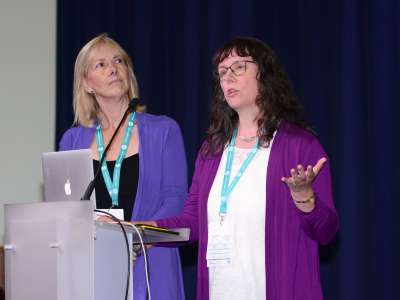
Being new to the world of posture and wheeled mobility, for me, attending the annual PMG conference was exciting but quite daunting, as I was surrounded by experts in the field!
But I came away from the conference feeling inspired (if slightly frazzled!), and eager to learn more.
Working in a relatively small team, it was refreshing to meet and hear from other occupational therapists, but also people from other backgrounds who found their paths crossing into posture and wheelchairs. I was also looking forward to sharing my experiences/learning points afterwards.
My report is about the breakout session which covered the topic of powered mobility in early childhood. It included a presentation by Roslyn Livingstone about a loan scheme in British Columbia where a group of children and their parents took part in a trial of powered mobility devices. This was part of a study funded by PMG which Roslyn, and her colleague Debbie Field, presented about on the following morning in the plenary theatre (see photograph - Debbie on left).
My report focuses on the practical use and implications of the loan scheme, and on my own learning from a clinical perspective.
I have had little experience working with children, and never saw myself in a role involving paediatric practice. Deciding to go into the world of wheelchairs changed all that, and I have really enjoyed working with children and families. When choosing which conference breakout sessions to attend, the topic of powered mobility use in early childhood intrigued me, as this was something that had never crossed my mind. I had always assumed that a young child with mobility issues would be pushed around by their parents/carers.
Admittedly, my first thought was of the risks posed by small children driving fairly powerful electric wheelchairs, concerned about the danger to others and damage to infrastructure. This commonly held view prompted discussion in the room: we don’t stop children from walking or crawling for fear of them bumping into things, and they learn how to avoid doing this over time. So, why would we stop children reliant on a wheelchair having a similar learning experience?
The loan scheme included children with various levels of disability and cognitive abilities, some who ordinarily wouldn’t be considered for powered mobility. I was also surprised, as many parents in the loan scheme were, at how the devices looked very much like toys, and were able to incorporate postural support when required.
I started to think about some of the children I had seen in my new role, and of the impact something like this would have on their lives. Of course, from an NHS perspective currently, there are constraints in the form of finance, time scales and criteria to be considered.
I have since looked into similar schemes here in the UK, and found that there are various government-led and charitable programmes available, using some of the same products as the loan scheme in British Columbia, and with set eligibility criteria. I feel it would be good to explore these schemes further for my own interest and development.
Part of the discussion in the session was around a child’s relationship with movement versus function, and the different types of equipment and seating that can be used to meet their various needs. It was interesting to consider a point raised by Roslyn that, in the wheelchair services, it is typically when a child turns five and starts school that wheelchairs are introduced, when it can be difficult for both the parents and the child to adjust to. Implementing devices from a younger age can help with this transition from movement/play/participation into being a functional driver.
My takeaway message from this presentation was simply that movement in any form is important for children, because it enables play/exploration of environments and social interaction. This may seem fairly obvious; however as someone who doesn’t have a lot of experience in this area, the presentation helped me see things from a new perspective.
It is also important to consider the goals/expectations of the parents/carers. They could well be apprehensive at first of the risks involved with the new equipment, therefore ensuring a holistic and multi-disciplinary approach in collaboration with the parents is essential.
Thinking as an occupational therapist, this also incorporates the fundamental principle of ‘meaningful occupations’. At this stage of their lives, the most important thing for children is taking part in activities and games with peers/siblings; therefore having access to a mobility device potentially enhances their lives. It is also about stimulation and having fun, again something vital for a child of any age or ability. It was interesting to consider the use of a powered mobility device as part of a therapeutic intervention, to practise skills in play, social engagement and attention, not just for mobility requirements.
This was a really positive learning experience for me, and encouraged me to have an open mind about the use of powered devices in childhood.
Members of PMG can view this presentation by clicking here.






.jpg)



no comments
Add your comment...